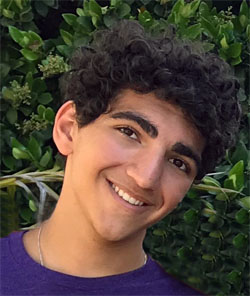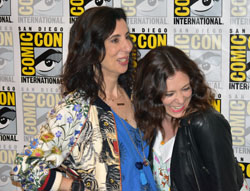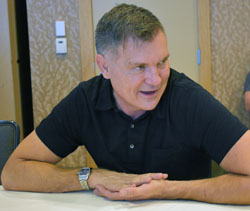Story and photos by Shor M. Masori


SAN DIEGO — Rachel Bloom (Robot Chicken, BoJack Horseman, her own comedic music videos) and Aline Brosh McKenna (The Devil Wears Prada, Morning Glory, 27 Dresses), co-creators of Crazy Ex-Girlfriend, told journalists at Comic-Con that the musical dramedy’s final 18 episodes on the CW will deal with “the themes of redemption and recovery.”
Bloom stars as Rebecca Bunch, an attorney suffering from an undiagnosed mental illness, who gave up her supposed dream job at her practice in New York to chase an old high school boyfriend, Josh Chan (played by Vincent Rodriguez III) after a chance encounter with him. This leads her to West Covina, California, where she has a new exciting life and could potentially find happiness.
The third and most recent season saw her lowest points in the series. She begins by trying to exact revenge on Josh Chan after he leaves her at the altar in the season two finale and this, as well as a suicide attempt, leads her to discover that she has Borderline Personality Disorder, and begins her work to getting help.
“We’ve watched her spiral over the first three seasons, and obviously, she bottomed out in season three, which saw her sent to prison for a crime (that she was not truly, legally responsible for) and so it’s been sort of a gradual rising for her… a bumpy journey towards her happiness and mental health,” McKenna said. Rebecca had “a lot of progress but also many setbacks.”
So, in the fourth and final season, commented Bloom, Bunch will be “learning how to implement things that she’s learned about. Who she is inside.” She will grapple with living her life and “taking responsibility for your actions and your own happiness.”
Asked if Rebecca would be happy when the series comes to an end, McKenna commented, “it depends on how you define happy.”
For some women, she said, happiness has been defined as something that comes from an external source – the prince in fairy tales who marries her. “Women are kind of sold narratives of happiness which aren’t very inner driven, that are sort of externally driven,” McKenna said. “That’s really what we’ve been trying to do: understand what it’s like to live inside those narratives and to try to break free of them.”
When asked what’s next for the two of them, the creators responded that they are now facing the added work of an 18 episode season and storyline, as opposed to the show’s regular 13 episode season. This also means that the show will have more musicals than planned, as each episode has an average of two song and dance numbers, each with their own unique style. They were “happily surprised” when the network ordered more episodes. said Bloom.
Bloom, who is Jewish, said that “it’s looking that the final moments, or the final ending, is actually very similar to what we pitched five years ago, but I think it’s hopefully going to be seen as a summation.”
“And, definitely,” she teased, “the final song –what we have planned—is not what you’d expect.”
*

At the same Comic-Con event, Kevin Williamson, creator of Scream and Dawson’s Creek, as well as author of The Politically Incorrect Guide to Socialism and The Case Against Trump, introduced his new show: Tell Me a Story. He said that re-imagining old fairy tales and fables like “Hansel and Gretel” and the “Three Little Pigs” allows him the freedom both to engage in modern social and political commentary and at the same time to plumb the same emotions that engaged the creativity of 19th-century writers like the Brothers Grimm.
Tired of the usual TV set-up, he said he was intrigued by the idea of Tell Me a Story because it reminded him of Scream, “of deconstructing the horror genre.” The advantage of the Tell Me a Story format, he said, is that it doesn’t follow the usual arcs of storytelling, in which, for example, a good person makes a mistake, remedies it, and goes back to being a good person. In this continuing series, a good person might turn bad, a bad person might turn good, and both might start and stop over and over again during the process.
Williamson uses the stories from the 19th century but changes the angle that they are told from. “Hansel and Gretel” was originally about the hunger of poor children kicked out of their house because their parents can’t feed them. Instead, it is about a veteran coming out of Iraq. Now Gretel is “scarred inside and out, and she’s been thrown away by her country… thrown into the woods of New York with her brother who has been thrown away by his parents and lost on drugs.”
He asked journalists to try to imagine if a modern-day brother and sister, like Hansel and Gretel, had to live in the woods of New York City’s Central Park and fend for themselves. Or, if the wolf, having been beaten down by society and had just lost everything, “just wanted someone to pay for it” so he blows the lives of those responsible, the three little pigs (particularly that one with the brick house,) apart. Williamson believes that sentiment is “very America.” He wondered how would one go about it? Instead of huffing and puffing, would he figure a way to inflict psychological and “metaphorical” damage on them?
He says that his episode about The Three Little Pigs “is probably our most politically charged. It really is about Rage America and how this really quiet man, this little sort of liberal Democrat, realizes maybe it’s time to go buy a gun.” He wants to make the audience wonder, “Will he do it? Or will he save himself before he turns a corner? Or maybe he should turn a corner.” Williamson said he would like this to be a messy story, but one that presents both sides.
*
Masori is a combination writer and photographer for San Diego Jewish World. He may be contacted via shor.masori@sdjewishworld.com